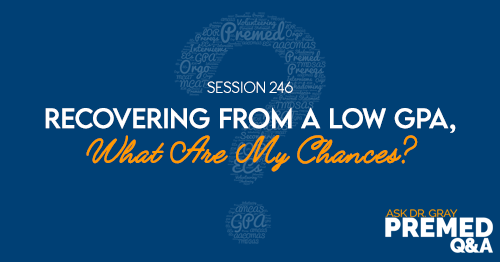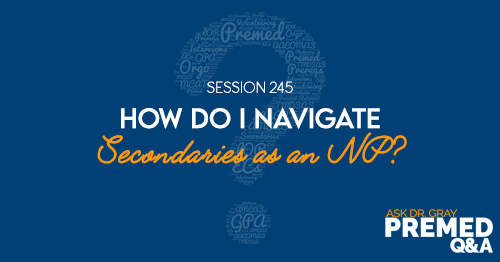Apple Podcast | Google Podcast
Session 128
This student is wondering how med school admissions will view transfers between different schools. I also answer other questions about school lists, HPSP, etc.
Listen to this podcast episode with the player above, or keep reading for the highlights and takeaway points.
By the way, the episodes in this podcast are recordings of our Facebook Live that we do at 3 pm Eastern on most weekdays. Check out our Facebook page and like the page to be notified. Also, listen to our other podcasts on MedEd Media. If you have any questions, call me at 617-410-6747.
[00:21] Question of the Day
Q: “How do admissions committees see transfers between undergraduate institutions for financial and personal reasons?
A: It happens. Students go to one school expecting one thing – whether they have financial problems, have homesickness, the culture doesn’t fit, or whatever it may be – and transfer.
There’s nothing you need to explain. It is what it is. Somebody may ask at an interview. But the most general answer is that they switched colleges because they couldn’t afford it. There’s usually not much drama behind those answers so you don’t have to worry about it.
[01:34] Themed Stories in a Personal Statement
Q: “I read in your personal statement book the don’ts section, and one of them is don’t have any themes. And the theme that was presented was like the jungle. I understood that part. Since I’m a writer, I theme my stories. Is that an acceptable idea?
When you see patients, it’s all about their stories. And that’s how I frame it in the lens of the personal statement. The idea is you want to tell their story very well, especially as a scribe and as a physician where you’re in a unique position to tell their story.
In the personal statement, that’s how I frame it. I tell two or three main stories of experiences. I have the seed, and then I watered that seed all the way through.
And at the end of each paragraph, I come back to that story idea of I saw a patient that was wronged with how their story was told. Is that an acceptable theme? Where does that fall into the rest?”
A: There’s no rule set in stone. Even my own rules are made to be broken, if they work well. So try it, and then let’s get some feedback on it and see what that looks like.
My gut is going to tell me that it probably isn’t going to work. And that it’s going to be more of a distraction, especially in that reflection part, which is supposed to really hammer home. Telling a story about a story can be distracting.
But try it and see. Maybe you can massage it so that you get a little bit of both where you still have that story theme in there. But you’re also being a little bit more direct to why you’re having that story in the personal statement to begin with.
[04:13] How to Show Interest in Your Top School
Q: “How do you let your top schools know that you’re interested in them the most without just flat-out telling your number one school?”
A: Especially after you get an interview at that school, you have a much better leverage to tell them you’re going if they accept you, which is through the letter of intent.
The application is your love letter and that’s your interest. Outside of that, there’s really not much else you can do other than really solidify in your secondary essays. And that’s assuming they’re very school-specific essay prompts of why you want to come to the school and why the school is of interest to you.
However they ask those questions, really hammer home why you’re interested in that school. And that’s where doing research about each school and not just cherry picking schools based on MCAT and GPA is very important.
Q: If they bring up the question of how many other schools have you applied to, how do you answer that question without directly telling them that there are others above you?”
A: I really wouldn’t worry about that type of question. Schools know that you’re applying to other schools.
'Schools are not dumb. They know that students are applying to lots of schools, just because that's the game that you have to play.”Click To Tweet[08:16] Looking for HPSP-Friendly Schools
Q: “How do I figure out if a school is HPSP-friendly?”
A: The way HPSP works is you get into medical school first. Then you technically apply for the scholarship now that you have at least one acceptance to medical school. And so in terms of the scholarship in the school, there’s really no direct correlation.
Once you’re in school, for the most part, you’re pretty hands off from the military. You go to school and they don’t want to bother you. Your job is to come out, graduate, and practice medicine.
Usually, the military will have some training for you in between first and second year, depending on whether the school has a summer between first and second year. It also depends on when you get the scholarship.
And when school starts. There’s some training before school again, again, depending on when you actually get the scholarship. So that’s usually Commissioned Officer Training (COT).
And if you don’t have that, then you don’t go to the training. You just do all the training after you graduate school and during your active duty time. So there isn’t really a big need to do a lot of research to determine if a school is “HPSP-friendly” or not.
[12:04] How Schools Sort Out Applicants
Q: “Some schools get a lot of applications. Especially some MD schools. Yeah. You see 10,000 plus applications? How in-depth do you think they’re actually looking at all of those applications? Should a student have confidence that their application is being looked at?”
A: Each school is probably getting between 20 or 25 to 40 or 50 applications per seat. Then a Residency Program Director I recently spoke with said that for his surgical residency program, he got 1,300 applications for those six seats. That’s 216 applications per seat. So it only gets worse from here on.
What we call in the military is the “rack and stack” where they look at all of the applications and go from top to bottom in terms of MCAT and GPA, or whatever is important for them. Then each reviewer takes in batches of applicants to look into.
They go through their process and score the applications and figure out who they are going to invite for an interview. And once they fill up all their interview spots, then that’s it. And maybe they only got halfway through that full stack. That’s just the name of the game, unfortunately.
Whether you’re going to end up being reviewed or not shouldn’t be the question in your mind at this point because you have no control over that.
You don’t know what each school is doing and you have no control over any of that. The only thing that you can control is having a good GPA and a good MCAT score. Do well with all of your extracurriculars and put together a strong story in your application. Then submit it to the schools where you think you’re going to be a good fit. And then let them do the rest.
[15:56] When to Click Submit
Q: “When is it the best time to submit within the application cycle?”
A: It depends on the turnaround time and how many students click Submit on that first day. AMCAS’ verification process is really the bottleneck. I’ve seen some students submit day one and get verified in two weeks. Some students submit day two and get verified in a month. That’s because of so many students submitting that first day.
If you submit your application within the first month or so, you’re probably going to be fine in the big picture of things, whether you’re in that first wave of applications or not.
My general advice to submit early. And I had Dean Rivera who’s the Dean of Admissions at NYU, and he says that a lot of times, that backfires on students. Because it’s the super strong students who are trying to submit very early as well. And as a weaker student, you may get lost in the sea of really strong students.
And so, maybe it will be beneficial for you to wait a few weeks just to let all the gunners through and then submit your application.
'There's a lot of luck in this process of when you submit your application, who else is submitting it at the same time, and what the process is at each individual school.”Click To TweetSchools have different ways of reviewing applications. One school may take down applications in batches and decide to pull down 100 applications at a time. For instance, they would see 4.0 and 520 students. And if you had a 3.4 and a 510, then you aren’t going to make the cut. And so, you’re done for that school for that application cycle.
Whereas another school may take all the applications and just constantly be pulling them into their pile. And then you could end up in a spot where you will get invited for an interview just depending on that school.
[18:53] Next Cycle Predictions
Q: “Any predictions for the next cycle? Because I know that everyone’s throwing around the idea that especially this current cycle, there are a lot more applications than last year and the year before, and more so than the usual jumps. Do you foresee that ridiculous jump again?”
A: I don’t think the numbers of applications that we saw is any sort of trend that we’re going to see moving forward. A lot of students rushed an application because some schools out there said that they were going to accept students without an MCAT.
“Some students don't want to take the MCAT so they rush through an application.”Click To TweetIn my opinion, what we’re going to see is a lot of those students who rushed an application last cycle are going to be re-applicants this cycle. And so we’re going to potentially see a “normal” application cycle again moving forward, where not a huge amount of students are applying.
The biggest amount of applications for this last year had nothing to do with COVID, other than schools were being more lenient when it came to volunteer hours, shadowing hours, MCAT, etc. And students were trying to take advantage of that and shortcut the system.
And that, in my mind, is just going to backfire on them. They’re just going to be back in the normal application cycle that they were supposed to be in, to begin with.
Links:
Medical School HQ Facebook page
Medical School HQ YouTube channel
Instagram @MedicalSchoolHQ
The Premed Playbook: Guide to the Medical School Personal Statement
SEARCH SITE
LISTEN FOR FREE












